The bicycle as historical weapon
From the saddle of a bike you are both free of and trapped by industrial society and all of it's many horrors. The bicyclist is viewed as an enemy to the motorist whose very roads were built by the hard work of the good roads movement begun by cyclists in the 1890's and capitalist industrialists who would abandon the freedom of the bicycle for the mass produced profit creating automobile, in this sick circle of consumerist culture.
From the bicycles very beginnings as a rich mans plaything to todays over costumed road racing techies, this machine's beauty has been vilified by it's users, and builders and organizers, perpetuating this societies, racism, sexism and class war profiteers/ industrialization, domestication and alienation.
Looking at this machines history, only touched upon here, and it's power to transform our very being as free people, it becomes a slap in the face how fast a man with black skin could become a champion and just as quickly excluded from racing, how quickly a women could be condemned for wearing sensible clothing, how quickly a beautiful machine could enter the battle field of colonialism, how quickly the police would turn them into weapons against us, how easily the automobile industry could take the streets away from the people ~ how a perfect transportation vehicle could be turned into merely a child's toy and forced off the roads, where serious men must commute in fierce competition with the exclusion of all others.
Chronology of the Growth of Bicycling and the Development of Bicycle Technology
by David MozerNote: Many people claim credit for inventing the first bicycle. The answer to the question often depends upon the nationality of who you ask; the French claim it was a Frenchman, Scots claim a Scotsman, the English an Englishman, and Americans often claim that it was an American. Since the early 1990's the International Cycling History Conferences, with proceedings Cycle History (San Francisco), has worked to get past the jingoism. Our current understanding of the history of the bicycle suggests that many people contributed ideas and developments:
Date Development
|
1418 |
Giovanni Fontana built the first human powered land vehicle --
it had four wheels and used an endless rope connected via gears to
the wheels. |
|
1493 |
Sketches showing a primitive version of a bicycle, purported
drawn by Leonardo
da Vinci, surfaced in 1974. Further examination of the
drawings indicates these are not by da Vinci's hand. The
speculation that these are a sketch by a pupil after a lost
drawing by da Vinci is also considered false. An age test was
performed, but the library in Milan (belonging to the Vatican)
conceals its negative outcome, see
http://www.cyclepublishing.com/history/leonardo%20da%20vinci%20bicycle.html
. Experts consider the sketches a hoax. |
|
1791 |
Comte de Sicrac is credited with building the "celerifer"
- purportedly a hobby horse with two wheels instead of a rocker.
This is now considered a patriotic hoax created by a French
historian in 1891. It was debunked by a French researcher in
1976. In fact, a Jean Sievrac (!) of Marseille obtained an
import price for a four-wheeled speed coach called celerifer in
1817. |
|
? |
Heinrich Mylius' bicycle, the Heimat Museum, Themar, Germany |
|
1817 |
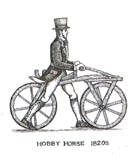 Variously
called the running machine, velocipede, Draisienne and dandy
horse, it was invented by Karl Drais, in response to widespread
starvation and the slaughtering of horses, the consequence of a
crop failure the year before (caused by the eruption of
Tambora). It had a steer-able front wheel. This is the first
appearance of the two-wheeler principle that is basic to cycling
and motorcycling and minimizes rolling resistance. The velocipedes
were made entirely of wood and needed to be balanced by directing
the front wheel a bit. People then did not dare to lift the feet
off safe ground, therefore the velocipedes were propelled by
pushing off with the feet. After the good harvest in 1817
riding velocipedes on sidewalks was forbidden worldwide, since the
velocipeders used the sidewalks, and because they could not
balance on the rutted carriageway, the fad passed. It took nearly
50 years, until a roller-skating boom created a new public with a
better sense of balance. For more information see:
http://www.maxime-verlag.de/presse_Drais/2005_01_29newscientist.html
and
http://www.karldrais.de/?lang=en&sid=bd15ff8c6ef29db0e7dd1d7e6e1680ae Variously
called the running machine, velocipede, Draisienne and dandy
horse, it was invented by Karl Drais, in response to widespread
starvation and the slaughtering of horses, the consequence of a
crop failure the year before (caused by the eruption of
Tambora). It had a steer-able front wheel. This is the first
appearance of the two-wheeler principle that is basic to cycling
and motorcycling and minimizes rolling resistance. The velocipedes
were made entirely of wood and needed to be balanced by directing
the front wheel a bit. People then did not dare to lift the feet
off safe ground, therefore the velocipedes were propelled by
pushing off with the feet. After the good harvest in 1817
riding velocipedes on sidewalks was forbidden worldwide, since the
velocipeders used the sidewalks, and because they could not
balance on the rutted carriageway, the fad passed. It took nearly
50 years, until a roller-skating boom created a new public with a
better sense of balance. For more information see:
http://www.maxime-verlag.de/presse_Drais/2005_01_29newscientist.html
and
http://www.karldrais.de/?lang=en&sid=bd15ff8c6ef29db0e7dd1d7e6e1680ae
|
|
1839 |
Another entry in bicycle lore: Kirkpatric Mcmillan, a Scottish
blacksmith adapted a treadle-type pedals to a bicycle, is
considered a hoax, see the David
Herlihy's book. |
|
1863 |
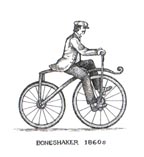 Bone
Shaker or Velocipede: Made of stiff materials, straight angles and
steel wheels make this bike literally a bone shaker to ride over
the cobblestone roads of the day. The improvement is a front wheel
with peddles -- direct drive, fixed gear, one speed. This machine
was known as the velocipede ("fast foot"), but was
popularly known as the bone shaker, They also became a fad, and
indoor riding academies, similar to roller rinks, could be found
in large cities. Bone
Shaker or Velocipede: Made of stiff materials, straight angles and
steel wheels make this bike literally a bone shaker to ride over
the cobblestone roads of the day. The improvement is a front wheel
with peddles -- direct drive, fixed gear, one speed. This machine
was known as the velocipede ("fast foot"), but was
popularly known as the bone shaker, They also became a fad, and
indoor riding academies, similar to roller rinks, could be found
in large cities.
|
|
1870 |
Ordinary: These are better know as the "high wheelers".
It is more comfortable to ride than its predecessor, but it
requires an acrobat so they popularity has always been limited.
This was the first all metal machine to appeared. (Previous to
this metallurgy was not advanced enough to provide metal which was
strong enough to make small, light parts out of.) The pedals were
still attached 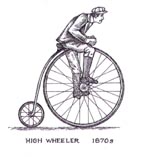 directly
to the front wheel with no freewheeling mechanism. Solid rubber
tires and the long spokes of the large front wheel provided a much
smoother ride than its predecessor. The front wheels became larger
and larger as makers realized that the larger the wheel, the
farther you could travel with one rotation of the pedals. You
would purchase a wheel as large as your leg length would allow.
These bicycles enjoyed a great popularity among young men of means
(they cost an average worker six month's pay), with the hey-day
being the decade of the 1880's. Because the rider sat so high
above the center of gravity, if the front wheel was stopped by a
stone or rut in the road, or the sudden emergence of a dog, the
entire apparatus rotated forward on its front axle, and the rider,
with his legs trapped under the handlebars, was dropped
unceremoniously on his head. Here the term "taking a header"
came into being. This machine was the first one to be called a
bicycle ("two wheel"). directly
to the front wheel with no freewheeling mechanism. Solid rubber
tires and the long spokes of the large front wheel provided a much
smoother ride than its predecessor. The front wheels became larger
and larger as makers realized that the larger the wheel, the
farther you could travel with one rotation of the pedals. You
would purchase a wheel as large as your leg length would allow.
These bicycles enjoyed a great popularity among young men of means
(they cost an average worker six month's pay), with the hey-day
being the decade of the 1880's. Because the rider sat so high
above the center of gravity, if the front wheel was stopped by a
stone or rut in the road, or the sudden emergence of a dog, the
entire apparatus rotated forward on its front axle, and the rider,
with his legs trapped under the handlebars, was dropped
unceremoniously on his head. Here the term "taking a header"
came into being. This machine was the first one to be called a
bicycle ("two wheel"). |
|
1872 |
Friedrich Fischer (German) first mass-produces steel ball
bearings, patented by Jules Suriray in 1869. |
|
1876 |
Browett and Harrison (English) patent an early caliper brake. |
|
1878 |
Scott and Phillott (English) patent the first practicable
epicyclic change-speed gear fitted into the hub of a front-driving
bicycle. |
|
1878 |
The first American manufacturer of cycles begun with the
Columbia Bicycle at the Weed Sewing Machine Company factory in
Hartford, Ct. The first regular trade catalogue was twenty pages
long. The first bicycles were the 60" High Wheelers and sold
for $125.00 when sewing machines sold for $13.00. |
|
1879 |
Henry J. Lawson (English) patents a rear wheel, chain-driven
safety bicycle, the “Bicyclette” (his earlier models were
lever driven). |
|
1880 |
Thomas Humber (English) adapts the block chain for use with his
range of bicycles. |
|
1880's |
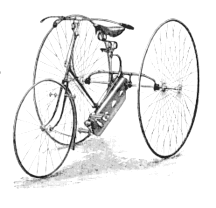 While
the men were risking their necks on the high wheels, ladies,
confined to their long skirts and corsets, could take a spin
around the park on an adult tricycle. These machines also afforded
more dignity to gentlemen such as doctors and clergymen. Many
mechanical innovations now associated with the automobile were
originally invented for tricycles. Rack and pinion steering, the
differential, and band brakes, to name a few! While
the men were risking their necks on the high wheels, ladies,
confined to their long skirts and corsets, could take a spin
around the park on an adult tricycle. These machines also afforded
more dignity to gentlemen such as doctors and clergymen. Many
mechanical innovations now associated with the automobile were
originally invented for tricycles. Rack and pinion steering, the
differential, and band brakes, to name a few! |
|
1880 |
Bicycle Activism: Good roads society organized by bicyclist and
lobbied for good
roads -- paving the way for motor vehicles!
|
|
1884 |
Thomas Stevens struck out across the country, carrying socks, a
spare shirt and a slicker that doubled as tent and bedroll.
Leaving San Francisco at 8 o'clock on April 22, 1884, he traveled
eastward, reaching Boston after 3700 wagon trail miles, to
complete the first transcontinental bicycle ride on August 4,
1884. After a pause, he continued east, circumnavigating earth,
and returning to San Francisco on Dec 24, 1886. See Around
the World by Bicycle, 2000 reenactment
of 1884 ride, and 2006 reenactment
of 1885 ride. |
|
1885 |
|
|
1888 |
Pneumatic tire: First applied to the bicycle by an Irish
veterinarian who was trying to give his sickly young son a more
comfortable ride on his tricycle. This inventive young doctor's
name was Dunlop. Now that comfort and safety could be had in the
same package, and that package was getting cheaper as
manufacturing methods improved, everyone clamored to ride the
bicycle.
|
|
1890 |
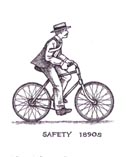 Safety
Bike: As the name implies the safety bike is safer than the
ordinary. The further improvement of metallurgy sparked the next
innovation, or rather return to previous design. With metal that
was now strong enough to make a fine chain and sprocket small and
light enough for a human being to power, the next design was a
return to the original configuration of two same-size wheels, only
now, instead of just one wheel circumference for every pedal turn,
you could, through the gear ratios, have a speed the same as the
huge high-wheel. Initially, the bicycles still had the hard rubber
tires, and in the absence of the long, shock-absorbing spokes, the
ride they provided was much more uncomfortable than any of the
high-wheel designs. Many of these bicycles of 100 years ago had
front and/or rear suspensions. These designs competed with each
other, your choice being the high-wheel's comfort or the safety's
safety, but the next innovation tolled the death of the high-wheel
design -- pneumatic tires. This is basically the same design as
standard contemporary bikes. The safety bike allowed large numbers
of people to take up cycling. Bikes were relatively expensive so
use was somewhat restrict to the elite. Safety
Bike: As the name implies the safety bike is safer than the
ordinary. The further improvement of metallurgy sparked the next
innovation, or rather return to previous design. With metal that
was now strong enough to make a fine chain and sprocket small and
light enough for a human being to power, the next design was a
return to the original configuration of two same-size wheels, only
now, instead of just one wheel circumference for every pedal turn,
you could, through the gear ratios, have a speed the same as the
huge high-wheel. Initially, the bicycles still had the hard rubber
tires, and in the absence of the long, shock-absorbing spokes, the
ride they provided was much more uncomfortable than any of the
high-wheel designs. Many of these bicycles of 100 years ago had
front and/or rear suspensions. These designs competed with each
other, your choice being the high-wheel's comfort or the safety's
safety, but the next innovation tolled the death of the high-wheel
design -- pneumatic tires. This is basically the same design as
standard contemporary bikes. The safety bike allowed large numbers
of people to take up cycling. Bikes were relatively expensive so
use was somewhat restrict to the elite. |
|
1890 |
Mass Production: The bicycle helped make the Gay Nineties what
they were. It was a practical investment for the working man as
transportation, and gave him a much greater flexibility for
leisure. Women would also start riding bicycles in much larger
numbers. |
|
1894 |
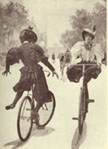 Change
In Social Order: Betty Bloomer's bloomers become very popular.
Ladies, heretofore consigned to riding the heavy adult size
tricycles that were only practical for taking a turn around the
park, now could ride a much more versatile machine and still keep
their legs covered with long skirts. The bicycle craze killed the
bustle and the corset, instituted "common-sense dressing"
for women and increased their mobility considerably. Victorian
women cyclists. American
Music and women bicyclists. Women
and bicycles. Change
In Social Order: Betty Bloomer's bloomers become very popular.
Ladies, heretofore consigned to riding the heavy adult size
tricycles that were only practical for taking a turn around the
park, now could ride a much more versatile machine and still keep
their legs covered with long skirts. The bicycle craze killed the
bustle and the corset, instituted "common-sense dressing"
for women and increased their mobility considerably. Victorian
women cyclists. American
Music and women bicyclists. Women
and bicycles. |
|
1894 1894 |
Bamboo bikes are manufactured.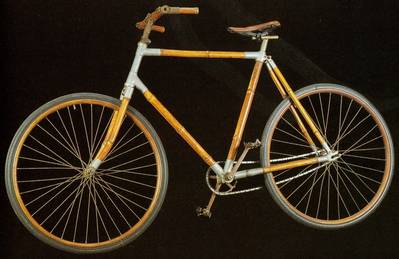 The
bicycle messenger business started in California when a railway
strike halted mail delivery for the Bay Area. An ingenious bicycle
shop owner in Fresno came up with the idea to deliver it by
bicycle. He set up a relay between Fresno and San Francisco, with
6 riders covering about 30 miles each. The last rider would cover
60 miles. The
bicycle messenger business started in California when a railway
strike halted mail delivery for the Bay Area. An ingenious bicycle
shop owner in Fresno came up with the idea to deliver it by
bicycle. He set up a relay between Fresno and San Francisco, with
6 riders covering about 30 miles each. The last rider would cover
60 miles. |
|
1894-95 |
Annie Kopchovsky (nee Cohan) (a.k.a.
Annie
Londonderry) was a Latvian Jewish immigrant to
Boston, who traveled around the
world. She started in Boston in June 1894 on her
Sterling bike and finishing her ride in Chicago in Sept 1895.
She was probably the first woman to take a bicycle on a world
trip. Reports suggest that she traveled mainly on ships and trains
-- riding her bicycles mostly to and from the main ports.
She was sponsored by The Londonderry Lithia Spring Water Co. |
|
1895 |
Ignatz Schwinn and Adolph Arnold formed Arnold, Schwinn &
Company to produce bikes. Albert Pope purchased 75 small
bicycle manufacturers to form the American
Bicycle Company. |
|
1896 |
"Let me tell you what I think of bicycling. I think it has
done more to emancipate women than anything else in the world. I
stand and rejoice every time I see a woman ride by on a wheel. It
gives woman a feeling of freedom and self-reliance." Susan B
Anthony
|
|
1898 1899 1900 |
Major Taylor was the American cycling sprint champion, and he
topped all European champions as well. Taylor was one of the first
black athletes to become a world champion in any sport. (Taylor is
celebrated in Andrew Richie's book
|
|
1899-1901 |
Bicycles first used in conflict in the Second Anglo-Boer War in
South Africa. Military
Bicycles: A Short History
|
|
1903 |
Internal hub gears invented by Sturmey
Archer. By 1930 these were used on bikes manufactured
around the world. There dominance lasted until the 1950s the
parallelogram derailleur was introduced. See also Sturmey
Archer Bicycle Hubs. |
|
1920 |
Kids Bikes: The focus of planning and development of the
transportation infrastructure was the private automobiles.
Bicycles use declined and the bicycle was considered primarily as
children's toys. Kids bikes were introduced just after the First
World War by several manufacturers, such as Mead, Sears Roebuck,
and Montgomery Ward, to revitalize the bike industry (Schwinn made
its big splash slightly later), these designs, now called
"classic", featured automobile and motorcycle elements
to appeal to kids who, presumably, would rather have a motor. If
ever a bike needed a motor, this was it. These bikes evolved into
the most glamorous, fabulous, ostentatious, heavy designs ever. It
is unbelievable today that 14-year-old kids could do the tricks
that we did on these 65 pound machines! They were built into the
middle 50s, by which time they had taken on design elements of jet
aircraft and even rockets. By the 60s, they were becoming leaner
and simpler.
|
|
1930 |
Tullio Campagnolo patents the quick release hub. |
|
1930's |
Schwinn introduced the fat tire, spring fork, streamline
Excelsior, designed to take the abuse of teenage boys, which was
the proto-type mountain bike. The Schwinn Excelsior frames became
the model for the early mountain bikes almost fifty years later. |
|
1934 |
Recumbents
banned from racing. This had the effect of putting the
recumbent bicycle design in the closet for fifty years, until it
was re-discovered, primarily by MIT professor David Gordon Wilson
and his students. |
|
1938 |
Simplex introduced their cable shifted derailleur. |
|
|
Historic European footage of unusual bikes from the late 1930s
and early 1940s. www.youtube.com/watch?v=jdlpJqHxLxk
|
|
1940 |
Women
bicyclists in the French Resistance. by Rebecca G.
Halbreich, published in Ex
Post Facto, 1994 |
|
1950s |
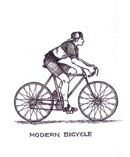 Tullio
Campagnolo introduced cable-operated, parallelogram derailleur.
Campagnolo. For two decades Campagnolo equipment dominated
true racing bikes. Eventually, he acquires 135 patents. Tullio
Campagnolo introduced cable-operated, parallelogram derailleur.
Campagnolo. For two decades Campagnolo equipment dominated
true racing bikes. Eventually, he acquires 135 patents. |
|
1958 |
Women ride in the first-ever World Championships on the road
and track. Balina Ermolaeva becomes the first women's World
Sprint Champion; Elsy Jacobs takes the road race. |
|
1962 |
Renaissance: President's Council of Physical Fitness. Renewed
interest in bicycle for recreation and fitness. This was the seed
of a new major bicycle boom that accelerated through the 60's. The
"English 3-speed" was the fancy consumer model of the
time. Before the end of the decade it was the 10-speed derailleur
"racing bike" which dominated the American market (the
derailleur had been invented before the turn of the century and
had been in more-or-less common use in Europe since). |
|
1970 |
Earth Day: Increased awareness of westerns civilization's level
of consumption of natural resources, air pollution, and
destruction of the natural environment. This generated a new spurt
in the growth of bicycle sales and bicycling, especially around
college campuses. |
|
1973 |
Oil embargo: Fuel shortages and shifts in relative price of
transportation options created an environment which encouraged
bicycle commuting. Many of the new recruits to bicycling stuck to
it after the end of the embargo and became enthusiasts. There was
also reinvigorated interest in the engineering of bicycles,
including renewed interest recumbents
and fairings. |
|
1977 |
The prototype of the mountain bikes were first developed in
Marin Co, California, north of San Francisco. Joe Breeze,
Otis Guy, Gary Fisher, and Craig Mitchell were the earliest
designers, builders and promoters. |
|
1978 |
A new round of steep oil prices increases further encouraged
bicycling. More bikes than car were being sold in the USA. Triple
chain-ring cranks had become widely available, adding to the range
of situation that bicycle were practical for. |
|
1980's |
Renewed interests in health and fitness, by the middle and
upper class perpetuated the acceptance and growth of commuting,
recreational and touring bicycling. |
|
1980's |
Bike messengers develop should backs to carry large envelopes
flat. The style migrates into general use as an alternative
to back packs, ruck sacks and purses. |
|
1980's |
Aerobic exercisers take the padding out of bike shorts and use
them in exercise class. The style migrates into general use
-- some wearers haven't exercised in decades. |
|
1984 |
Tour de France Feminine run for the first time (winner:
Marianne Martin.) |
|
1984 |
Women's road race included in the Olympics for the first time
(winner: Connie Carpenter.) Successes by American racing
cyclist in the 1984 Olympics drew attention and added prestige to
cycling. The ranks of racing cyclists grew substantially.
|
|
1984 |
Cogs began to be added to the rear gear cluster the number of
speeds increase from 15 to 18, 21 and 24.
|
|
1984 |
Three-time national XC champion Jacquie Phelan founds the
Women's Mountain Bike and Tea Society; the first formal outreach
organization for women. WOMBATS is dedicated to introducing
women to mountain biking in a fun, non-competitive environment. |
|
1990 |
Shimano (Japanese) introduces integrated brake/gear levers. |
|
1994 |
Sachs (SRAM) introduces PowerDisc, the first mass-produced
hydraulic disc brake system. |
|
1996 |
Mountain Bike compete at the Olympic Games for the first time
in Atlanta, GA USA. |
|
1986 |
Department of the Interior and Nielson surveys show that
bicycling is the third most popular participatory sport after
swimming and general exercise.
|
|
2000 |
Rohloff Speedhub 14 speed internal hub gearing system, with no
overlapping ratios and a gear range as wide as a 27-speed
derailleur system. |
|
2002 |
Campagnolo introduces 10 cog rear cluster, allowing 30 speed
bicycles. |
No comments:
Post a Comment
Note: Only a member of this blog may post a comment.